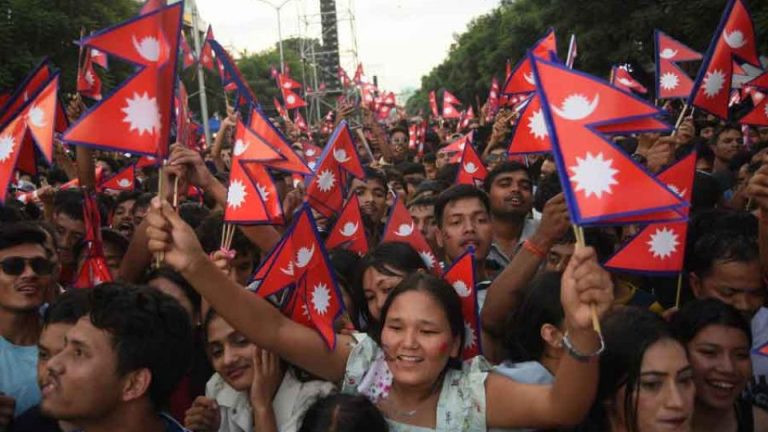The frequent use of Nepal’s national flag in political protests and rallies has raised new concerns. Experts and officials are now calling for clearer rules on how and where the flag can be used.
Nepal’s flag has been spotted in many recent events organized by political parties. Protesters have used it during demonstrations, draped it over their shoulders, and waved it as a sign of resistance. But current rules do not clearly say if this is allowed.
The government says it will now review these rules due to growing misuse.
What do the current rules say?
Nepal’s “Procedure on the National Flag of Nepal-2012” provides guidelines on how to use the flag. Part 3, Section 62 of the document states that the flag should only be used for hoisting.
While the public can use the flag, it must be done respectfully. The law does not allow using the flag for decoration or wearing it. Despite this, many groups have used it during protests and campaigns.
National pride or political tool?
Former law minister Nilamber Acharya said people should respect the flag and avoid using it in protests. He suggests using party flags instead during political events.
“The national flag belongs to the whole country,” he said. “It should not represent just one group.”
Umesh Mainali, a former home ministry official, also raised concerns. He said some parties use the flag to attract more people to events. “If people won’t come under a party flag, using the national flag is misuse,” he said.
But others see things differently.
Senior advocate Purna Man Shakya said the flag belongs to all citizens. He argued that using it during protests is not necessarily wrong. “People who do not agree with the protest won’t join it just because of the flag,” he said.
Government steps in
Ramchandra Tiwari, spokesperson for the Ministry of Home Affairs, said the ministry is taking the issue seriously.
He said the current flag procedure does not clearly ban its use at political rallies, but misuse is becoming a problem.
Tiwari stressed that while using the flag is a matter of national pride, it should never be used for personal or political gain.
Recent protests spark debate
The issue became more urgent after a protest on March 28 at Tinkune in Kathmandu. The event was organized by pro-monarchy groups, including the Rastriya Prajatantra Party-Nepal (RPP-Nepal), to demand the release of leaders arrested during an earlier rally.
During that protest, many participants wore or waved the national flag. Some carried it while setting fire to vehicles and attacking offices. Two people died in the chaos, and 13 others were seriously injured.
RPP-Nepal leader Rabindra Mishra and businessman Durga Prasai were arrested for inciting the protest.
Despite the violence, RPP-Nepal’s spokesperson Rajaram Bartaula defended the use of the flag. He said patriotic people have the right to show national pride.
“Using the flag should not be called misuse,” he said.
Not just pro-monarchy groups
The national flag has also been used by other political parties. When Rabi Lamichhane, leader of the Rastriya Swatantra Party, was arrested last October, his supporters held protests in Kathmandu and Pokhara. Many carried the national flag during those rallies too.
Various groups use the flag when they want more people to join events. This is especially common when the group’s own political flag may not appeal to the wider public.
Legal and constitutional questions
Constitutional expert Chandrakanta Gyawali said the use of the national flag is governed by strict rules. He said any use of the flag outside official or approved events is illegal.
“The national flag stands for the whole country,” he said. “There are rules, and breaking them is against the constitution.”
Experts say that with political protests increasing in Nepal, there is an urgent need for clear and updated rules on the flag’s use.
Without better regulation, the flag may continue to be used in ways that hurt its meaning and reduce its value as a unifying national symbol.
What’s next?
The Home Ministry has said it will now look more closely at how the flag is being used. New rules may be introduced to stop future misuse.
Until then, the debate over the flag’s role in politics is likely to grow. As Nepal continues to face political tensions, the flag—once a symbol of unity—is at risk of becoming a symbol of division.


